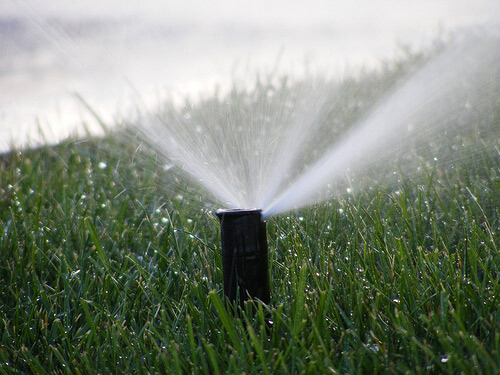
Two of the most important things you’ll need to do to achieve a healthy, great-looking lawn this spring are to water and mow it properly. Follow these tips to keep your lawn green and the root system healthy.
Give Your Lawn an Inch of Water per Week
Between rainfall and watering, your lawn needs an inch of water each week. Without sufficient water, grass begins turning brown and the root system grows more slowly.
Check soil moisture.
Let’s say it rained earlier in the week, and you’re not sure if you need to water or not. You can figure that out by checking for moisture about 6 inches down into the soil – that’s the depth an inch of water will soak down to. Poke a slender stick or a screwdriver about 6 inches down. If the soil is dry, you will need to water.
Go for a thorough soaking.
Frequent light watering is not good for your lawn. It keeps only the upper inch or two of soil consistently moist, which leads to a shallow root system. Instead, water deeply just once or twice a week. This encourages the roots to grow deeper, making your lawn healthier and more drought resistant. Just be sure not to overwater.
Water in the morning.
Watering in the heat of the day results in water loss due to evaporation, and watering at night increases the risk of lawn diseases. So, whenever you can, water before 10 am. When that’s not possible, between 4 and 6 pm is the next best option.
Mow Like a Pro
One of the biggest mowing mistakes you can make is to consistently cut your grass too short. For starters, because the depth of the root system is proportional to the (average) height of the grass, very short grass results in a shallow root system – and you want the root system to grow deep and strong. It also speeds up evaporation of moisture from the soil.
Here’s the scoop on the right way to mow.
Mow for the type of grass you have. There are several different grasses popular in the Atlanta area, and they have different ideal or optimal heights:
- Bermuda, seeded: 1 to 2 inches high
- Bermuda, sodded: 0.5 to 1.5 inches high
- Fescue: 3 to 4 inches high
- Zoysia: 0.5 to 1.5 inches high
Don’t cut off more than one-third at a time. Whichever grass you have, never remove more than one-third of the blade in a single cutting. For example, if you have Bermuda that is three inches high, you should remove no more than one inch.
Mix up your mowing pattern. Mowing from the same starting point and in the same direction every time can create ruts in your lawn. Vary your pattern by alternating between mowing lengthwise and widthwise.
Now you’re ready to kick off spring with lawn care know-how – and these spring specials from Simply Organic. It’s our way of saying “thanks” for helping us bring natural, nontoxic lawn care to Atlanta and beyond.

